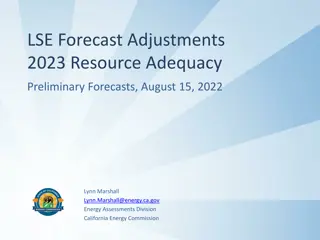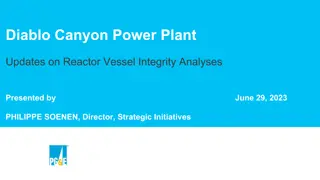Near-Term Resource Adequacy Benefits of Retaining Diablo Canyon
The presentation discusses the resource adequacy benefits of retaining Diablo Canyon in California to mitigate potential shortages in 2025 and 2026 due to possible delays in deploying storage, geothermal, and pumped storage projects. Keeping Diablo Canyon operational could help meet the state's reliability needs and clean energy goals, reducing the risk of rolling blackouts and lowering CO2 emissions.
Uploaded on Nov 16, 2024 | 0 Views
Download Presentation

Please find below an Image/Link to download the presentation.
The content on the website is provided AS IS for your information and personal use only. It may not be sold, licensed, or shared on other websites without obtaining consent from the author. Download presentation by click this link. If you encounter any issues during the download, it is possible that the publisher has removed the file from their server.
E N D
Presentation Transcript
Near-Term Resource Adequacy Benefits of Retaining Diablo Canyon PRESENTED BY Sam Newell Principal and Leader of The Brattle Group s Electricity Practice PRESENTED TO The California Senate Committee on Energy, Utilities and Communications Subcommittee on Clean Energy Future PREPARED FOR Policy Impact on behalf of Carbon Free California AUGUST 9, 2022
California Will Need Many New Resources for Reliability New Resources Needed for Resource Adequacy (nameplate GW) The CPUC determined that a 22.5% reserve margin is needed to operate reliably under adverse conditions 100 To meet that, they ordered the procurement of 11.5 GW Net Qualifying Capacity (NQC) New Solar 80 New Storage New LLT New Wind CEC s Midterm Reliability Analysis translates that into >20GW of new nameplate capacity over the next 5 years, of resources consistent with clean energy goals: >8.7 GW Solar by 2025 >10 GW of 4-hr Storage by 2025 2 GW of Long-Lead Time Resources by 2026 60 40 Baseline Capacity 20 0 Our analysis takes the above as a goal and Recognizes that deploying so much capacity will require siting and interconnecting resources at unprecedented rates; and supply chain issues may continue Examines the impact of potential deployment delays on the ability to meet the 22.5% RM 2022 2022 2023 2023 2024 2024 2025 2025 2026 2026 brattle.com | 1
But Possible Delays in Storage Deployment Could Expose the State to Shortages in 2025 that Diablo Could Mitigate Adequacy depends on adding > 10 GW storage (nameplate capacity) With max build rate of 6 GW/yr in 2023 But the max historical rate was 1.8 GW in 2021 Even this may be optimistic with tight supply chains 2025 Net Qualifying Capacity (GW) 60 4.5 GW capacity shortfall Capacity needed to meet 22.5% reserve margin: 57.6 GW New Solar New Storage -3.4 GW 50 New Wind If no more than 1.8 GW/yr materializes, a 4.5 GW NQC shortfall could occur by 2025 This could risk rolling blackouts in extreme weather Could be worse if some events exceed 4 hours Could be worse if PV deployment is limited to recent rate of 1 GW; would reduce the value of storage 40 Baseline Capacity 30 20 10 Retaining Diablo could reduce the gap by 2.2 GW For the September peak (Base Case assumes the Diablo unit retires by August 26th, 2025 as planned) 0 Total available NQC If Storage Deployment Does Not Exceed 1.8 GW/year (nameplate) Base Case brattle.com | 2
Retaining Diablo Could also Mitigate Shortages in 2026 from Possible Delays in Deploying Geothermal and Pumped Storage 2026 Net Qualifying Capacity (GW) Adequacy in 2026 further depends on 1 GW each of new geothermal and pumped storage Extremely optimistic given permitting challenges and construction timelines for pumped storage No large geo projects are in the queue or under development; would take several years to develop 3.7 GW capacity shortfall 60 Capacity needed to meet 22.5% reserve margin: 58.1 GW New Solar New Storage -1.8 GW -1.9 GW 50 New LLT New Other New Wind 40 If these fail to materialize by 2026 and batteries are limited to 1.8 GW/yr, a shortfall of 3.7 GW could occur (or 2 GW if only one of these occurs) Baseline Capacity 30 20 RetainingDiablo could cut the shortfall in half Or eliminate it if only one of the two issues occur Diablo will also help California reliably meet its long- term clean energy goals, reduce cumulative CO2 emissions by 40 MMT through 2032, and save over $4 billion NPV through 20451 10 0 Delays in deploying geothermal/PSH Base Case Total available NQC If Storage Deployment Does Not Exceed 1.8 GW/year (nameplate) brattle.com | 3 1S. Newell, W. Chang, D. Murphy and R. Sreenath, Retaining Diablo Canyon: Economic, Carbon, and Reliability Implications, on behalf of Carbon Free California, June 9 2022
About Brattle The Brattle Group answers complex economic, finance, and regulatory questions for corporations, law firms, and governments around the world. We are distinguished by the clarity of our insights and the credibility of our experts, which include leading international academics and industry specialists. Brattle has 500 talented professionals across four continents. For more information, please visit brattle.com. Our Services Our People Our Insights Research and Consulting Renowned Experts Thoughtful Analysis Litigation and Support Global Teams Exceptional Quality Expert Testimony Intellectual Rigor Clear Communication The views expressed in this presentation are strictly those of the presenter and do not necessarily state or reflect the views of The Brattle Group or its clients brattle.com | 4























